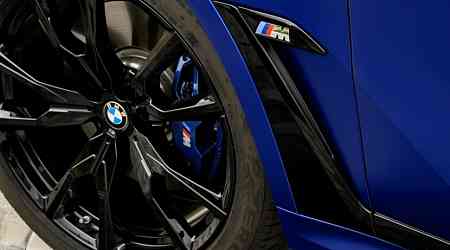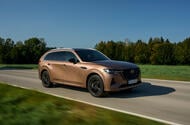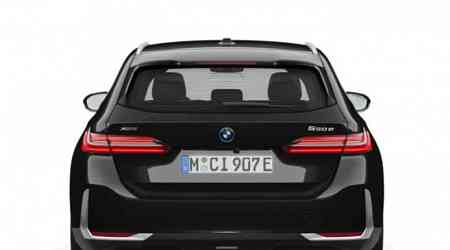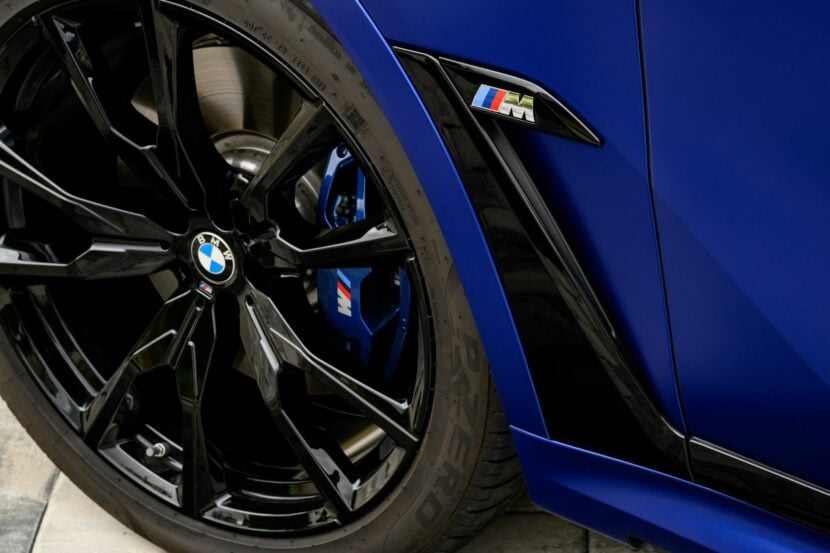Why we’re running it: A switch from FWD to RWD brings better range, efficiency and drivability – but what about everyday appeal?
Month 1 - Month 2 - Month 3 - Month 4 - Specs
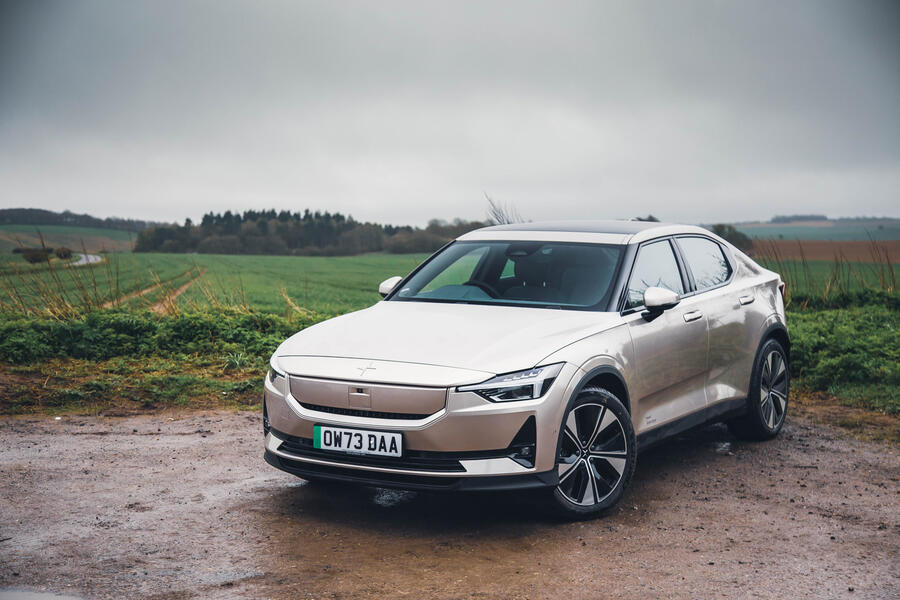
Life with a Polestar 2: Month 4
Slick EV proves its mettle on yet another long trip - 25 September
There’s nothing quite like the trepidation of a ford in the road. Will the journey end in soggy embarrassment and be followed by a large bill and pictures of my car on the local Facebook group showing the idiocy and arrogance of another out-of-towner who bit off more than they could chew?
Those thoughts were running through my head as a whopper of a river ford stood between me and the road out of Sidmouth in Devon.
A Ford of a different kind answered the question of the water’s depth: a Fiesta casually blasted through the splash, the water hardly any deeper than the sidewalls of its tyres. I followed suit and it was back to the main road.
The drive to Devon was the latest road trip of around 500 miles I’ve done in our Polestar 2 this summer. Such journeys don’t feel such a big deal now in a big-range EV like the 2, because such little extra brain power is required to work out when to charge. I set off from home with a full charge, and either one fast charge on the road or a couple of slower charges, while parked up somewhere, covers it.
There has been a notable increase in good-quality and reliable public chargers. You can typically spot the bad ones a mile off: they look large and old. Payment for charging is increasingly now contactless and apps showing charger availability and speed have become more reliable and trustworthy than ever.

The 2 is a very good road-trip car for up to four people for a couple of nights away, given that the boot is a good size. I’ve done a trip for three and there was plenty of space left, and neither people nor possessions felt crammed in. When it’s just me travelling, my golf clubs can lie flat with plenty of room to spare.
Some 30deg C-plus weather this summer did turn the 2 into a bit of a greenhouse. The huge panoramic roof was a significant factor in that, of course, and, as mentioned in a recent report, the seat material isn’t exactly on the breathable side. I don’t really like the stuffiness of air-con, but the heat from both the roof above and the seats below often leaves me with no choice.
Yet the hot weather also does wonders for the 2’s efficiency. On one toasty day trip to the continent with the temperature again in the 30s, at times I was seeing five miles per kWh efficiency on the more built-up sections of road. That’s remarkable and would stretch the range to around 400 miles.
Carrying passengers is making me more aware of the lumpiness of the 2’s ride, however. Back-to-back bumps can send heads tossing and the jarring can make you wince a bit. Perhaps familiarity makes me notice it less when I’m flying solo, but there are better-riding and more supple electric cars of this size out there, including the BMW i4.
But no electric car can match the coolness and kerb appeal of the 2, even after a few years on sale. The unusual Jupiter paint perhaps contributes to that as a conversational starter, but the amount of people who will ask questions about the 2 or turn their heads when the car drives past them for a lingering stare seems only to be increasing.
Love it
Efficiency
It got even better with the hot weather. Have seen five miles per kWh come up now.
Loathe it
The panoramic roof is an option that doesn’t pair well with the Weavetech trim on the seats.
Mileage: 8222
Keyless entry but plenty of safety measures - 18 September
Many modern cars frustrate with overly complex ways of entering and locking, but the 2’s balance is excellent. There’s a good old-fashioned key fob with lock, unlock and boot release buttons, but keyless entry is still possible with the fob in your hand and a tug on a handle that still sits proud of the body. As for the boot, there’s a button on the tailgate that both closes and locks it. No faffing here.
Mileage: 8190
Range anxiety? Absolutely not... - 4 September
It’s easy to see how charging falls down the list of key EV stats behind range, battery size and efficiency, but the 2’s rapid peak charging rate of 205kW means it can gain 80 miles in the time it takes me to use the loo and buy a coffee at a service station. I’ve yet to have anything even close to resembling range anxiety in the 2, as its key EV stats would make for a compelling Top Trumps card.
Mileage: 8001
Life with a Polestar 2: Month 3
How will 60% more power affect first-class all-rounder’s drive? - 21 August
As we and car makers are increasingly finding out with electric cars, less often means more.
Some of the first wave of single-motor EVs were packed with ludicrous amounts of instant torque, as manufacturers had shiny new toys to play with in electric motors, the result being otherwise humdrum hatchbacks tugging you towards the nearest ditch.
Then there were the early dual-motor EVs, with power and torque figures to shame Ferraris. This turned them only into pseudo-performance cars that could go quickly in a straight line but not much else. The overriding feeling after some time behind the wheel was nausea.
We're now largely past the first phase of single-motor EVs being given torque to overwhelm the driven wheels and the driver, car makers having learned that just because it's there, doesn’t mean they have to serve it all up all of the time. A far more useful everyday nippiness has emerged.

However, we're still largely in the era of dual-motor EVs marketed as performance options based almost entirely on the headline figures, and our verdict of these models is often the same: go with the single-motor version for a much sweeter driving experience and as much real-world performance as you will ever need. Efficiency will always be better too.
The Polestar 2 falls into the less-is-more category, not that the Swedish brand hasn’t tried to position it as a serious performance machine that’s about more than just headline numbers.
When the single-motor 2 that I'm running was recently off the road having a parking sensor repaired, I arranged to have a go in a dual-motor 2 with the Performance Pack fitted. This version gets a peak of 469bhp, up from the 295bhp of my version, as well as the thing the 2 is known for: manually adjustable Öhlins performance dampers.
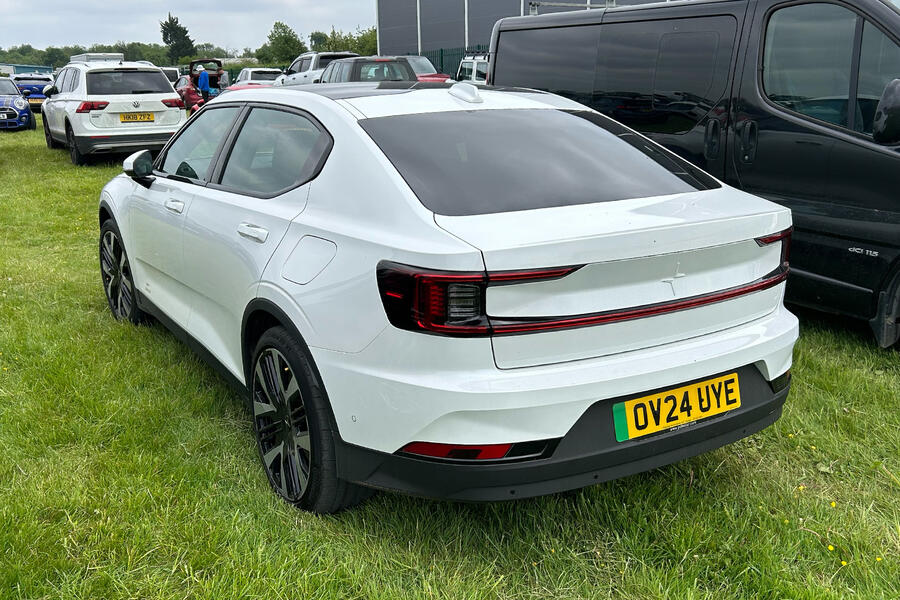
This still feels like a remarkable addition to a two-tonne-plus family car built in China, rather than something made by hand for pure pleasure, like an Ariel or a Caterham, and credit to Polestar for valuing mechanical interaction and not just sticking the settings behind another menu in the touchscreen.
That said, the dampers aren’t the easiest to adjust, requiring a dealer visit to change them, which neither of which could be done in my week with the car, so I was left with a ride that’s already firm enough made even more so.
It’s worth noting that when our Matt Prior ran in a pre-facelift 2 with these dampers, he clicked them back to a more comfortable setting and found the ride to be much more agreeable.
Firm ride aside, it's a car with a lot of grip and stability yet not much excitement should blistering acceleration not be your thing. You can feel last night’s dinner, let alone today’s breakfast, sloshing around under hard loads, and any novelty value soon expires.

I do like the visual upgrades, which lift an already cool-looking car even further: the 20in wheels look fantastic and the yellow trim flashes, including on the seatbelts, don’t feel gimmicky.
Overall, though, it was a case of ‘pleased to have tried it, not sad to see it go’, as I had been craving the better all-round abilities of my usual single-motor car.
This 2 increasingly feels like a modern interpretation of the six-cylinder diesels that until recently you would have found in the form of a BMW 330d or 335d, delivering excellent real-world pace, engaging dynamics and high efficiency in a premium package.
Love it
Hello Handsome
No matter the colour, spec or trim, the 2 looks fantastic. Prefacelift cars are ageing well, too.
Loathe it
Cross-traffic alert
It has a habit of false activation, slamming your brakes on when it wrongly thinks you’re going to hit something in reverse.
Mileage: 7750
Polestar 2 boasts smart seats - 14 August
For the most part, I’m really enjoying the trim on the seats in the 2. Called Weavetech, it’s a tough fabric that feels modern and looks stylish as an alternative to leather. Yet it shares one common trait with that material: an ability to get rather toasty on one’s backside in warmer weather. I’ve always found ventilated (cooled) seats a bit gimmicky, but they would be very welcome here.
Mileage: 7445
Life with a Polestar 2: Month 2
Night follows day and our editor takes an electric long-termer to Bruges - 17 July
I’d forgive you for not remembering the exact locations of my journeys over the past three years in this section of the magazine, given that there have been more than 10,000 pages of editorial in that time, but this is now the fourth electric car in three years that I’ve taken to Belgium (yes, Bruges again) for a long weekend (no, I’m not on the tourist board, I just like the cobbles, canals and beer, okay?), and your fourth single-page write-up on how an EV tackles that journey awaits.
The Polestar 2 follows an Audi Q4 E-tron, a Kia Niro EV and a BMW iX in having made this 500-or-so-mile round trip, and it was the best and most enjoyable one yet, not only because the charging infrastructure has become so much better and more plentiful but also because the car was so much more efficient.
In the electric car lexicon, range remains the most important criterion for many, yet it is simply a by-product of efficiency and battery capacity. This 2 has a large, 82kWh battery, yet it's so much more efficient with it than rivals, allowing you to go so much further without having to charge as a result.
On firing the car up, it indicates 330 miles of range from a full charge pretty much as standard. In many EVs, you can expect that figure to plummet with any kind of extended motorway running, but not so in the 2. The efficiency is routinely around four miles per kWh, no matter the journey, which translates to a range of 330 miles – a figure I’m very comfortable with. That the indicated range is a reliable and trustworthy figure isn’t a given based on my time in electric cars.
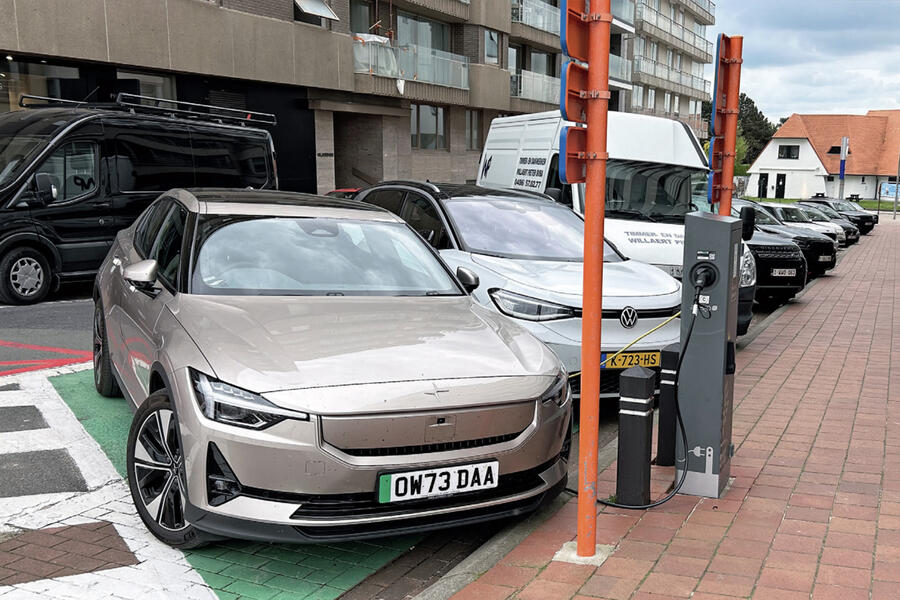
Previously, I’ve considered 3mpkWh efficiency in an EV to be the equivalent of around 40mpg in an ICE car using a method no more scientific than real-world experience. On that basis, I would happily call 4mpkWh 50mpg, which gets you to the economy of a good 2.0-litre diesel car. And there’s plenty of room for improvement: Lucid, which makes the most efficient EVs of all, says 8mpkWh is an achievable medium-term goal, which would equate to 100mpg. Maybe my scale will need recalibrating...
My earlier EV trips to Bruges followed a similar format: set off with a full charge at home, do a splash and dash at the now-universal Tesla Superchargers at the Folkestone Eurotunnel terminal, top up again at a motorway fast charger on the other side in case I can’t get a charging space overnight in Bruges and then do the same on the way back, regardless of whether an overnight charge was achieved.
This time around, I did a splash and dash at Folkestone only and still arrived in Bruges with more than 50% battery remaining. I didn’t hunt too hard for a roadside charger, because you have to pay a premium for the parking compared with a multi-storey and the charging isn’t cheap on top. Instead, the electrons came from parking up in some nearby towns on a day trip to the Belgian coast, so by the time I’d done another splash and dash at the Tesla rapid charger on the Calais side of the tunnel on the way home, I managed to get home with around 30% battery still showing. The on-the-go charging was less than £30 all in, on top of the £20 home charge to begin with.
If it was the first time I’d done the journey, I’d have probably been even more cautious and sought out an overnight charge to head home with 100% and with another top-up en route. Yet such is life with EVs: the more you drive them, the more you get to know them, learn their language and spot the good ones from the not-so-good ones.To that end, this 2 is the best motorway electric car that I’ve yet driven.
Love it
Angel-eyes
It was a real boon for manoeuvring within those alloy-endangering Eurotunnel carriages.
Where to stick it
There’s no flat surface on the rear of the 2 to put your UK sticker for driving abroad.
Mileage: 6419
Life with a Polestar 2: Month 1
Polestar impresses for motorway efficiency - 12 June
It’s easy to get sucked into talking solely about range when it comes to EVs, but range is the result of the battery size and the car’s efficiency. There are larger batteries than the 2’s 82kWh one (a capacity oddly plastered on the side of the car), but I’ve yet to live with an EV that’s as efficient at motorway speeds. I can see 4.0mpkWh on a good run.
Mileage: 3111
Welcoming the Polestar 2 to the fleet - 29 May 2024
Sometimes in this job, we go on drives in cars that we don't end up writing about because we've told you everything you need to know about it already.
I had one such drive late last year in a Polestar 2 - a car then recently facelifted and a few weeks earlier subjected to a full Autocar road test. I had some time in it before a flight home following the inaugural Polestar Day in Los Angeles, where the Swedish electric car maker unveiled its future model plans and strategy.
What I had thought would be a chance to fill my knowledge bank and to catch up with my road test colleagues turned into one of the most memorable drives that I had all year - and not just for the rather lovely Californian autumn sun and scenery.
The 2 was as little as I remembered. Pre-facelift, this 4.6m-long fastback was likeable but not an automatic choice in a market ever expanding with choice. While a creditable first effort, it wasn't outstanding and felt alternative in its positioning and execution.
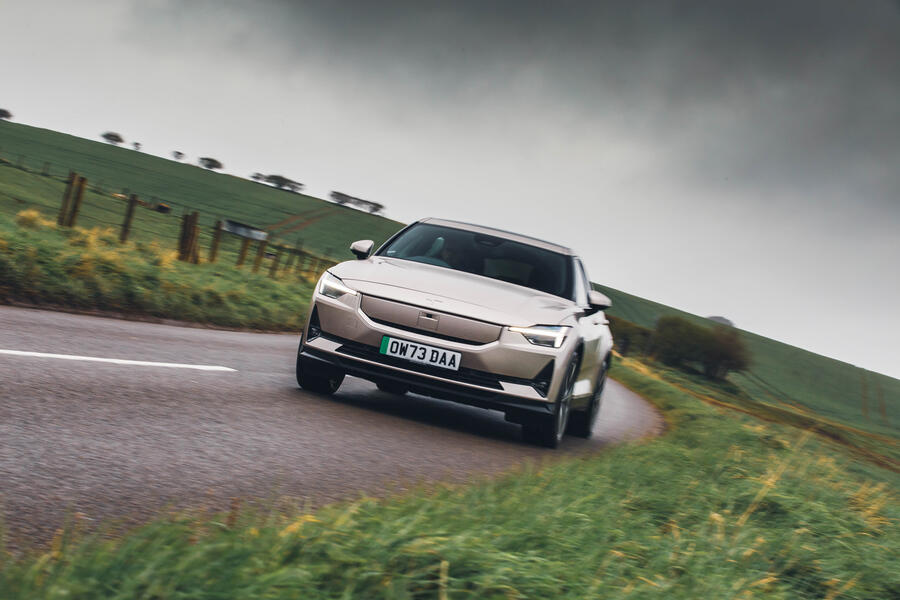
Its mid-life facelift brought with it most of the customary changes, like some updated visuals and extra kit, along with the 'usual' for EVs of more range and improved battery and motor technology.
Yet it also brought with it a switch from front-wheel drive to rear-wheel drive - something practically unheard of but which we might yet see more of in the future, as such changes are now very much technically feasible in the electric era.
The 2 felt much more substantial as a result, with better rolling refinement, driver engagement and acceleration.
The switch to rear-wheel drive had obvious dynamic benefits but was mainly done to boost efficiency at a steady cruise (more mass is over the back axle now, so more torque is being used for forward motion), and the pre-facelift 2's real-world range of 200 or so miles became closer to 270 miles when we road tested it.
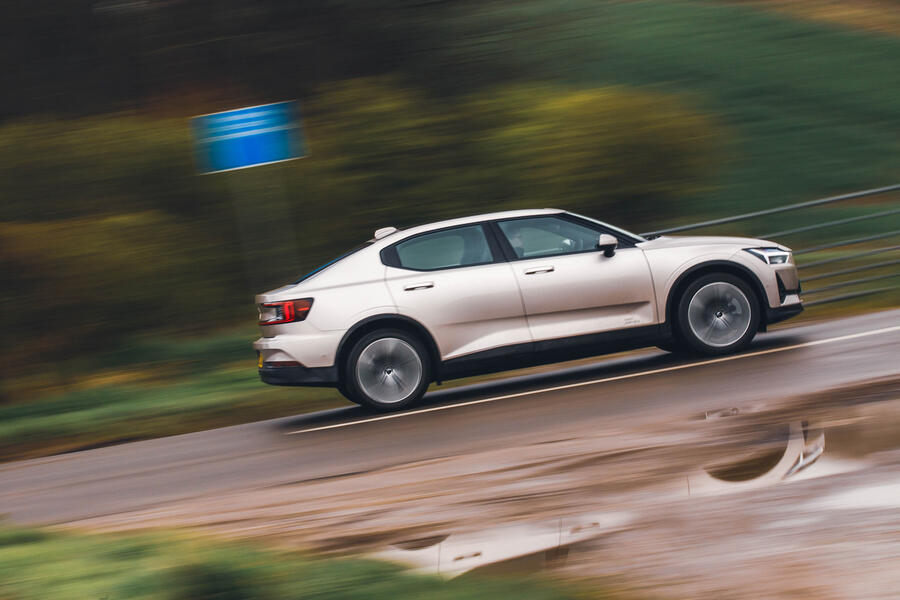
A 2 is now back with us for an extended stay, and after my memorable first experience, I'm excited and delighted to be running it. We've had a 2 on our fleet before: Matt Prior ran a range-topping Long Range Dual Motor with the Performance Pack, complete with the fancy Öhlins dampers that you need a spanner to adjust.
This time, we've got a Long Range Single Motor, which feels like the sweet spot in the range. There's just one model below it, the Standard Range Single Motor, with a 69kWh battery instead of an 82kWh one and a 268bhp motor instead of a 295bhp one.
The Dual Motor version remains in the line-up as well, featuring the 82kWh battery. It has 416bhp as standard or 469bhp if you add the Performance Pack, which retains those Ohlins dampers.
I am keen to see how that top-rung model has evolved at some point over the next few months and will make sure I pop over to Prior's to borrow his spanner and see what he thinks of the progress made.
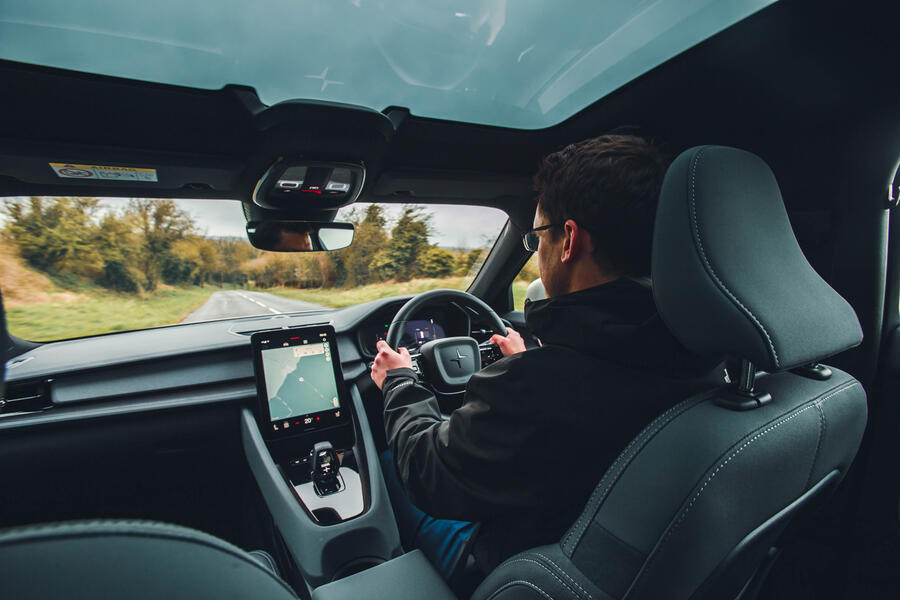
As is typical with new cars these days, options are grouped into packages. Two are offered - Pilot and Plus - and my test car has both. The former features all the assisted driving technology and costs £2000 on top of the base car's £48,950.
The latter costs £4000 and includes quite a few bits, from what's fast proving to be essential on EVs, such as a heat pump, to the added theatre of a panoramic roof and a Harman Kardon premium sound system, to clever features like the lid-in-lid' pop-up bag holder in the boot, which stops things sliding around.
The colour of our 2 is as nice as I've seen in the metal on any car for a long time. It's called Jupiter and costs £900. The interior trim looks great and feels good too, and for the record is called Slate Weavetech with Black Ash deco by Polestar.
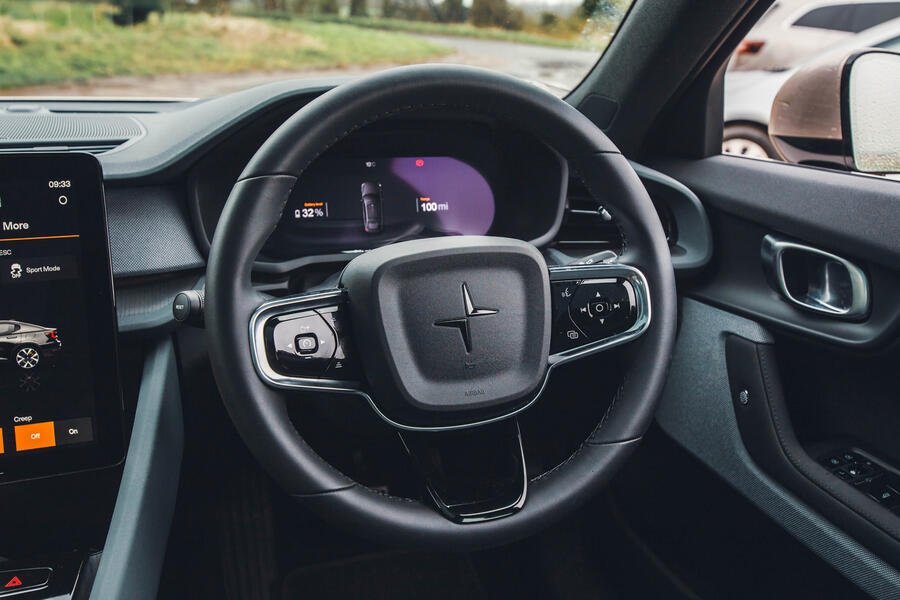
One question that has remained pre- and post-facelift concerns the 2's ride, which is firm. This again was shown in our road test on 20in wheels, but this car has 195, and so far the ride is better than I remember it being. That back-to-back comparison with the range-topper will be revealing for more than one reason, then.
One big part of the appeal of the 2 is its range, or more precisely its efficiency. The official range is a remarkable 406 miles, which as ever should be taken with a pinch of salt, yet in early testing I'm routinely passing the magic 300-mile barrier and pushing 330 miles on occasion.
This is a car with huge visual appeal inside and out and, my early experiences suggest, increased levels of driver appeal and even better efficiency.
I was apprehensive the day the 2 arrived for fear of it not being as good or as memorable in a soggy British spring as it was in a glorious Californian autumn, but it has already put those worries to bed.
Second Opinion
I thought the updated 2 was great when I first drove it: fast, frugal and pretty cool looking. Then I sat in the back of it and thought it was less great. I’m really interested to see if Mark’s rear-seat passengers find sitting virtually on the rear axle as grating and as nausea-inducing as I did, or if I was just being a typically fussy road tester.
Murray Scullion
Polestar 2 Long Range Single Motor specification
Specs: Price New £48,950 Price as tested £55,850 Options Plus Package £4000, Pilot Package £2000, Jupiter paint £900
Test Data: Engine Single front-mounted electric motor Power 268bhpbhp Torque 316lb ft Kerb weight 2490kg Top speed 99mph 0-62mph 7.4sec Fuel economy 4.2mpkWh (WLTP) CO2 0g/km Faults None Expenses None



















